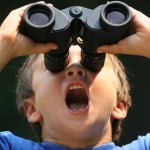 Did you know you can see the moons of Jupiter and Saturn with only a pair of binoculars? During the summer, there’s really nothing better than star gazing with a pair of binoculars with your kids, and I’m going to help you hit the highlights, even if you don’t know an atom from an angström. I’ve put together a list of my favorite picks from the northern hemisphere’s summer sky. So get out your binoculars, pop the popcorn, and spend time outdoors with your kids.
Did you know you can see the moons of Jupiter and Saturn with only a pair of binoculars? During the summer, there’s really nothing better than star gazing with a pair of binoculars with your kids, and I’m going to help you hit the highlights, even if you don’t know an atom from an angström. I’ve put together a list of my favorite picks from the northern hemisphere’s summer sky. So get out your binoculars, pop the popcorn, and spend time outdoors with your kids.
Need a pair of binoculars? For kids, I recommend the $35 pair Cometron by Celestron. They’re great for kids and beginners, and you can use them for terrestrial bird-watching as well as night-sky observing.
For adults, Orion’s 10×50 UltraViews are excellent. I personally own a set of these, and I’ve also added an L-adapter and camera tripod for longer viewing sessions.
ONLINE Stargazing!
We are going to have monthly stargazing! All you need are clear, dark skies and a group of kids! You don’t need binoculars, but they can be nice to have.
Here are star gazing videos you can watch by month:
Stargazing July 2020 (Coming soon!)
Stargazing August 2020 (Coming soon!)
[am4show have=’p8;p9;p96;p105;’ guest_error=’Guest error message’ user_error=’User error message’ ]
The Moon
The best time to view the moon is a few days before first quarter and after third quarter. (Click here for a Phases of the Moon Calendar). This way, you’ll be able to view the ‘terminator’ (the line between light and dark on the surface), which will make the craters pop out even more through your binoculars. If you have an inflatable raft, bring it out, pump it up, and stretch out on it as you view through your binoculars – it will greatly reduce the stress on your neck.
 If you’re viewing the full moon, one of the easiest things to find are the Apollo Landing sites. First, you’ll need a map: click here for a printable Moon Map. The image on the right shows the current moon phase. If the sky’s clear and the moon is big and bright, just pop outside and look up.
If you’re viewing the full moon, one of the easiest things to find are the Apollo Landing sites. First, you’ll need a map: click here for a printable Moon Map. The image on the right shows the current moon phase. If the sky’s clear and the moon is big and bright, just pop outside and look up.
The first thing you want to do is orient the map so you have it right-side up. The easiest way to do that is to find the ‘belly button’ on the moon (called Tycho). It’s the large crater near the bottom. Find it also on the Moon Map and presto! You’ve just found your first astronomy feature!
Now, let’s see if we can find where Apollo 11 landed. Are you ready?
The Apollo 11 mission was the first human space flight to land on the Moon. Launched on July 16, 1969, it carried Mission Commander Neil Alden Armstrong, Command Module Pilot Michael Collins, and Lunar Module Pilot Edwin Eugene ‘Buzz’ Aldrin, Jr. On July 20, Armstrong and Aldrin became the first humans to land on the Moon, while Collins orbited above. To find the Apollo 11 landing site, just go straight up from Tycho until you hit the first large, dark basin (called the Sea of Tranquility) and you’re there.
Planets
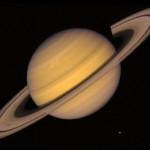 The moon, sun, and planets all follow an arc cross the sky called the ‘ecliptic’. Often you’ll find Venus as the bright star hanging in the western sky at sunset or the eastern sky at dawn, depending on the time of year. If you’re star gazing on a night when the moon’s also up, you’ll have two points you can connect so you can see approximately where this arc is in the sky.
The moon, sun, and planets all follow an arc cross the sky called the ‘ecliptic’. Often you’ll find Venus as the bright star hanging in the western sky at sunset or the eastern sky at dawn, depending on the time of year. If you’re star gazing on a night when the moon’s also up, you’ll have two points you can connect so you can see approximately where this arc is in the sky.
Mercury rises or sets near dawn or dusk, and is very hard to locate (owing to its close proximity to the sun). Saturn, Mars, and Jupiter change their location depending on the time of year, so you’ll need a star chart to help you out.
To find Uranus, Neptune, and Pluto, you’re going to need a seasoned astronomer with a telescope nearby. Uranus rises just before midnight, but it’s not visible with the naked eye in most skies. Same with Neptune – it also rises before midnight, but it’s such a faint object that unless you know exactly where to look, you’re not going to find it. Pluto, the dwarf planet, can be found in Sagittarius with an 8″ telescope and dark skies, as it’s 14th magnitude (see below for magnitude information).
Deep-Sky Observing
The next set of celestial objects require a dark sky and patience as well as a map to know where to look. You can try using an interactive Sky Map if you’re at the computer and want to plan out what you’re going to see tonight and familiarize yourself with the night sky ahead of time, or use the paper Sky Map which is the same one I personally use (it’s free) so you can print it out and take outside with you.
NOTE: The images below are larger and brighter than what you’ll see through your binoculars! What you’ll usually see is a fuzzy patch (sometimes green), whether it’s an open cluster, galaxy, or nebula. The reason you won’t see colors is that your eyes are tuned for green, so green is what you see the easiest in dark conditions. The binoculars will help you see bits of color that are usually invisible to your naked eyes. Without binoculars, you’ll be able to see about 4,000 celestial objects on a dark night. With binoculars, that number jumps to over 100,000!
The photos below were taken with a camera, which easily collects all the visible colors (not just green)! In addition, the images below were taken with a 8-14″ diameter telescope. While binoculars are like having two telescopes (one for each eye), they simply aren’t large enough to gather more light than a 14″ diameter telescope. However, the images you will see are brighter than if you were to look through a small telescope the same diameter as your lenses.
The numbers on binoculars refer to the magnification and the lens at the end. For example, 7×50 means you’re viewing the sky at 7X, and the lenses are at 50mm. Most people can easily hold up to 10x50s before their arms get tired. Remember, you’re looking up, not out or down as in normal terrestrial daytime viewing.
Long story short – look for fuzzy green smudges, and then reference the click-able images here for a better idea of what you’re looking at.
Click on the images below to view a larger picture.
Hercules Cluster (M13)
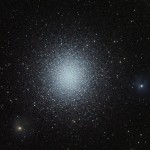
In the armpit of Hercules you’ll find the M13 globular cluster that looks like a spray of tiny diamonds in a telescope, but a faint fuzzy patch in your binoculars. While it looks like a cotton ball (or hairy armpit, depending on your point of view), it’s actually a massive collection of over 100,000 stars.
Globular clusters are groups of stars held together by their own mutual gravity… sort of like a big family reunion. You might need help finding Hercules for your location – it’s basically a box with arms and legs coming off each corner.
Before diving into finding these objects, spend time finding the constellations. When you do just one or two new constellations each night, you’ll be amazed at how many you can identify by the end of summer.
Scorpius Star Clouds (M6 & M7)
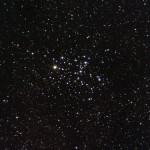
There are two open star clusters (smaller groups of stars, like the Pleiades) in Scorpio. You’ll find Scorpio near your south-western horizon after sunset. See if you can make out the claws, head, heart (red star), and stinger (shaped like a giant hook) using your naked eyes. Looking at the end of the stinger section through binoculars, you will be able to locate the Butterfly Cluster (M6) and Ptolemy’s Cluster (M7) in the same view.
M6 will be in the upper part of your field of view (image left) and has the rough outline of a butterfly. M7 is larger and brighter than M6, but even through binoculars you should be able to make out the subtle blue and yellow tints of the stars along with a gold sun in the center (especially if you have sharp eyesight). If you can’t, don’t worry – the fact that you found a fuzzy green patch is just as good!
Lagoon Nebula (M8)
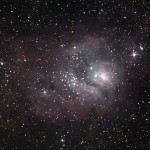
Can you find the teapot in the night sky? Originally called Sagittarius the Archer, this constellation looks like it’s pouring hot tea right onto Scorpius’s tail. The Milky Way runs right through the teapot in a way that makes it look like hot steam is coming out of the spout. It’s in this hot steam area that you’ll find all kinds of neat binocular treats!
The one we’re focusing on is the Lagoon Nebula (M8), which is a huge emission nebula. An emission nebula is just like it sounds – it’s a big cloud of gas that’s giving off light in different colors. Usually it emits light because a nearby hot star adding energy to the cloud so that it lights up. (More technically, the hot star’s high-energy photons ionizes the gas cloud.)
Swan Nebula (M17)
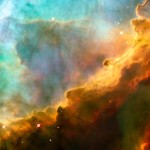
The Swan Nebula (M17) is another emission nebula just north of the lid of the teapot. While it doesn’t look much like a swan at first sight, here are two things to look for that really gave it the name:
1. Look for a straight bar of light along the side of the cloud.
2. Can you find the faint hook curving off the end?
The hook-bar appearance is what made astronomers first think of a swan. What do you think? Does it look like this in your binoculars?
Teapot Cluster (M22)
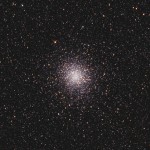
This globular cluster is going to look a lot like M13 (above) – like a cotton ball of stars. Just by scanning the Milky Way near the teapot, you’re going to find all sorts of viewing treasures… and this is one of the larger ones. You will be able to see a fuzzy halo around a bright core if you allow your eyes to rest on this object for several minutes and adjust.
When you look up at the night sky, it seems like the pinpoints of light are each isolated from each other. When viewed through your binoculars however, single stars can actually transform into tens of millions of stars. Globular clusters are massive groups of stars held together by gravity, using housing between tens of thousands to millions of stars (think New York City).
Dumbbell Nebula (M27)
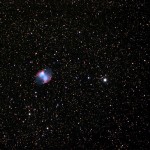
Dying stars blow off shells of heated gas that glow in beautiful patterns. William Hershel (1795) coined the term ‘planetary nebula’ because the ones he looked at through 18th century telescopes looked like planets. They actually have nothing to do with planets – they are shells of dust feathering away.
Usually you need a telescope to see a planetary nebula, but this is one you’ll be able to pick out with binoculars. Find the bright star Altair in the Summer Triangle (the three stars, Deneb, Altair, and Vega make up a large triangle in Cygnus the Swan). Draw a line between Altair to Deneb. Look for a tiny box about a third the way up from Altair toward Deneb.
Did you know that when you look at Sagittarius (the Teapot), you’re looking straight into the heart of our galaxy? Although it’s obscured by lots of dust and gases, when you point your binoculars at the teapot, you’re looking int he direction of the center of the Milky Way galaxy (and also into the heart of a dormant (non-feeding) super massive black hole).
The Coat Hanger
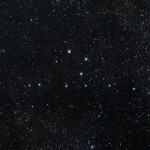
Do you see the coat hanger shape? It’s sort of tilted so the hook is on its side… got it yet? You’ll actually be able to see this tiny and distinct form through your binoculars on a dark night. Find the bright star Altair in the Summer Triangle (the three stars, Deneb, Altair, and Vega make up a large triangle in Cygnus the Swan). Now go a little to the northwest.
Can you count the six stars that lie in a straight line (for the coat hanger’s bottom section)? There’s another four in the hook shape, for a total of ten stars that are 7th magnitude.
The magnitude scale was invented by the ancient Greeks. The brightest stars they could see were a magnitude of 1, and the stars they could barely make out became magnitude 6. But that’s not the weird part… it’s the distance between the magnitudes that’s unusual. Let me explain…
A star one magnitude lower than another is two-and-a-half times brighter. For example, a magnitude 2 star is 2.5 times brighter than a magnitude 3 star. This makes a star that is five magnitude numbers lower than another exactly 100 times brighter. So, a magnitude 1 star is 100 times brighter than a magnitude 6 star.
Astronomers today have added negative magnitudes for super-bright stars and refined the scale to account for stars that were previously unseen. The brightest star in the sky is Sirius (magnitude -1.4), which is near the Orion constellation in the winter (for the northern hemisphere). The planet Mars varies in magnitude, but the brightest it gets is -2.8. Venus also changes in magnitude (due to distance and phase), but gets as bright as magnitude -4.4. A full moon measures at a magnitude -12.6. (And don’t ever look at the Sun. At magnitude -26.8 the Sun’s rays can damage your eyes!) Without a telescope, your eyes can just barely see magnitude 6 stars.
North America Nebula
This object is perfect for binoculars, as it’s too large for most telescopes! I’m going to warn you, though, you must have dark skies to see this one at all.
Look overhead after sunset and find the summer triangle (Deneb, Vega, and Altair) in the Cygnus the Swan constellation. Zoom your binoculars to the Deneb, slightly to the east, and you’ll make out a fuzzy green cloud in the rough shape of North America.
Did you know there’s a black hole in Cygnus? Once you’ve identified the constellation, you can boldly claim to have found the location of the first black hole ever found called Cygnus X-1.
Want more?
If your kids are crazy for astronomy and want to go above and beyond what we’ve covered here, then your next step is to contact your local astronomy club for their next public star party. If you want to move up to a telescope, check out our telescope recommendations here.
[/am4show]


ahh
today we have a good day
and
hopefully a good noght to watch the stars
Your own binocs? Great idea! Let me know how it goes…
if we ever get a good and not cloudy night, me and my sister were thinking about making our own constellations
problem is, we don’t get very many good and not cloudy days in the seattle area
Sure thing! Check out this website: http://www.pbs.org/seeinginthedark/explore-the-sky/your-sky-tonight.html for what’s up in your area of the world.
We live in a rural area of Malawi in Southern Africa. Do you have any maps or suggestions for what we should look for with our binoculars in the Southern Hemisphere?